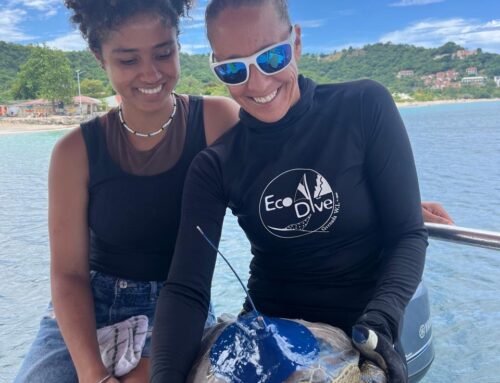Eco Dive is happy to be hosting Ph. D Student Ryan Horricks for the month of October and to be able to help facilitate his coral research. He is a happy face around the dive shop these days so our guests are sure to meet him and are welcome to ask him questions or are bound to share a boat trip out to one of the research sites together. More on Ryan’s work is included below.
Welcome Ryan!
Ryan Horricks
Ph.D. Student
Department of Pathobiology, University of Guelph
Rationale: Given the extreme importance of scleractinian corals to marine ecosystems it is crucial to gain further insights to the regenerative abilities of these animals. The current model for coral regeneration is the anemone, a close cousin and easily cultured, but one with enough differences that it is likely not preferable for useful information on corals. A model that uses a common reef-building species of Caribbean hard coral would have wide application and relevance. Regeneration studies in coral have used Montastraea spp. as model organisms and based on this we propose that the scleractinian star coral Montastraea cavernosa be used in this study. Its large polyp size will be particularly useful in characterizing individual polyp regeneration rates. Additionally, even among the severely degraded reefs of the Caribbean, M. cavernosa is one of the more commonly encountered scleractinian corals at moderate depths.
A working hypothesis is that the rate of regeneration is dependent on the condition of the reef. Consequently, field-based research in Grenada and Carriacou will involve studying rates of regeneration of standardized lesions on multiple M. cavernosa colonies from reefs of differing condition. Researchers will create standardized 12mm diameter circular lesions on M. cavernosa colonies both within and outside the boundaries of the marine parks in Grenada and Carriacou. Studies have shown that a large number of factors have an effect on regeneration in certain coral species but little quantitative work has been carried out directly on M. cavernosa to date. Nutrient levels, presence of a marine reserve, and reef condition will be assessed for their potential impact on coral regeneration. If these factors have a significant effect on coral regeneration a predictive model may be generated. Reef health will be assessed through photo belt transects. 30m x 0.5m photo belt transects will be used to quantify species percent cover, diversity, and richness. These values will be used as proxies for the health of the reef under the assumption that a reef with greater coral species richness, diversity, and percent cover values will be in better condition than a reef with lower values.
If you have any questions, comments, or concerns please do not hesitate to ask Ryan as he loves to talk about the ocean and his research!





